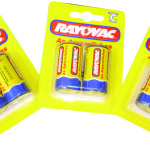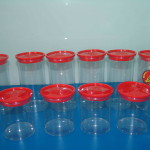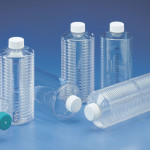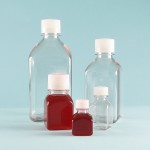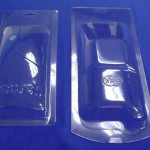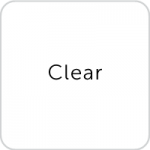Polyethylene Terephthalate Glycol/Amorphous Polyethylene Terephthalate
PETG is a material that only comes in a range of transparencies and has poor weatherability making it designed for packaging, trays and point of sale solutions. PETG is PET with Glycol which prevents having and brittleness if PET is overheated. While PETG is a bit softer and has a higher impact resistance it does scratch more easily than PET.
APET is great for vacuum forming and fabrication and has great impact strength and is a cost effective alternative for acrylic in some cases. It has good chemical resistance, clarity, transparency, gloss and it is FDA/BGA approved. APET is also easily recyclable. Unlike PETG, APET is available in a range of colours.
Applications
Both APET and PETG are used in a range of packaging applications. They are commonly used in food packaging because of their standard compliance. APET is also a great material for blister o clamshell packaging like the packaging of cables, toys, electronic items and household items and consumables.
While these PET materials are mainly used in packaging they can be used in other applications like covering posters, picture frames and even machine guards and covers.
Colours shown above are just representations of a particular colour and aren’t necessarily the finished plastic colour. Lighting conditions, monitor calibration and variances in the plastic colour processing can impact the colour of a given material. For more information on colour availability please contact us.
|
Thickness
|
Ava.
|
Thickness
|
Ava.
|
Thickness
|
Ava.
|
|---|---|---|---|---|---|
|
0.5MM
|
 |
4.5MM
|
 |
18MM
|
|
|
1MM
|
 |
6MM
|
20MM
|
||
|
1.5MM
|
 |
8MM
|
25MM
|
||
|
2MM
|
 |
10MM
|
30MM
|
||
|
3MM
|
 |
12MM
|
40MM
|
||
|
4MM
|
15MM
|
Please note that different materials have varying tolerances when it comes to thickness. A product should facilitate material variances +-0.2mm
|
Property
|
Value
|
Unit
|
|---|---|---|
|
Mechanical
|
||
|
Tensile Strength
|
26
|
MPa
|
|
Flexural Strength
|
77
|
MPa
|
|
Shear Strength
|
57
|
MPa
|
|
Impact Strength
|
1.15
|
J/m
|
|
Hardness
|
R115
|
M or R
|
|
Thermal
|
||
|
Working Temperature
|
62
|
°C
|
|
Vacuum Forming Temperature
|
137
|
°C
|
|
Thermal Expansion
|
6.8
|
10^-5/°C
|
|
Vicat Softening Temperature
|
85
|
°C
|
|
Miscellaneous
|
||
|
Specific Gravity
|
1.27
|
g/cm³
|
|
Water Absorption
|
0.2
|
% in 24 hr
|
|
Light Transmission
|
86
|
%
|
|
Dielectric Strength
|
410
|
Volts/Mil
|
|
Surface Energy
|
42
|
Dynes/cm
|
The information in the above data table is provided for educational purposes only in good faith and should only be used as a guide. As sheet material comes in a wide variety of grades, colours, textures and can contain different chemical properties, the figures only represent a typical insight into the specifications of the material. Information has been collated from a variety of sources. For more information on these figures and other properties please contact us.
| Resistant = |  |
Semi-resistant = |  |
Not Resistant = |  |
Blank = | Untested |
|
Chemical
|
Resistance
|
Chemical
|
Resistance
|
Chemical
|
Resistance
|
|---|---|---|---|---|---|
|
Acetamide
|
Freon and Frigen
|
Propanol
|
|||
|
Acetic Acid
|
 |
Fruit Juices
|
Pyridine
|
||
|
Acetone
|
 |
Glycerine
|
Salicylc Acid
|
||
|
Ammonia
|
 |
Glykol
|
Silicone Oils
|
 |
|
|
Anone
|
 |
Glysantin
|
Soap Solution
|
 |
|
|
Benzene
|
 |
Heating Oil
|
Soda Iye
|
 |
|
|
Benzine
|
 |
Heptane and Hexane
|
 |
Soda Solution
|
 |
|
Bitumen
|
Hydrochloric Acid
|
 |
Sodium Bisulphite
|
 |
|
|
Boric Acid
|
Hydrogen Peroxide
|
 |
Sodium Carbonate
|
 |
|
|
Butyl Acetate
|
 |
Hydrogen Sulphide
|
 |
Sodium Chloride
|
 |
|
Calcium Chloride
|
 |
Ink
|
 |
Sodium Nitrate
|
 |
|
Carbon Tetrachloride
|
 |
Iodine
|
 |
Sodium Thiosulphate
|
 |
|
Chlorbenzene
|
 |
Iso-octane
|
 |
Styrene
|
|
|
Chloroform
|
 |
Isopropanol
|
 |
Sulphur Dioxide
|
 |
|
Citric Acid
|
 |
Lactic Acid
|
Sulphuric Acid
|
 |
|
|
Clophene
|
 |
Linseed Oil
|
 |
Tar
|
|
|
Cupric Sulphate
|
Methanol
|
 |
Tartaric Acid
|
||
|
Cyclohexane
|
Methyl Ethyl Ketone
|
 |
Tetrahydrofurane
|
 |
|
|
Cyclohexanone
|
Methylene Chloride
|
 |
Tetralin
|
 |
|
|
Decalin
|
Milk
|
Toluene
|
 |
||
|
Diesel Oil
|
 |
Nitric Acid
|
 |
Transformer Oil
|
 |
|
Dimethyl Formamide
|
 |
Nitrobenzene
|
Trichlorethylene
|
 |
|
|
Diocthyl Phthalate
|
 |
Oxalic Acid
|
Triethanolamine
|
||
|
Dioxane
|
 |
Ozone
|
Trilon B
|
||
|
Edible Fats & Oils
|
 |
Paraffin Oil
|
 |
Urea
|
|
|
Ethanol
|
 |
Perchlorethylene
|
 |
Vaseline
|
 |
|
Ethyl Acetate
|
 |
Petroleum
|
 |
Water Cold
|
 |
|
Ethyl Ether
|
 |
Phenol
|
 |
Water Warm
|
 |
|
Ethylene Chloride
|
Phosphoric Acid
|
Wax
|
 |
||
|
Formaldehye
|
Potassium Dichromate
|
 |
Wine
|
||
|
Formamide
|
Potassium Iye
|
 |
Xylene
|
 |
|
|
Formic Acid
|
Potassium Permaganate
|
 |
The information in the above data table is provided for educational purposes only in good faith and should only be used as a guide. As sheet material comes in a wide variety of grades, colours, textures and can contain different chemical properties, the figures only represent a typical insight into the specifications of the material. Information has been collated from a variety of sources. For more information on these figures and other properties please contact us.


